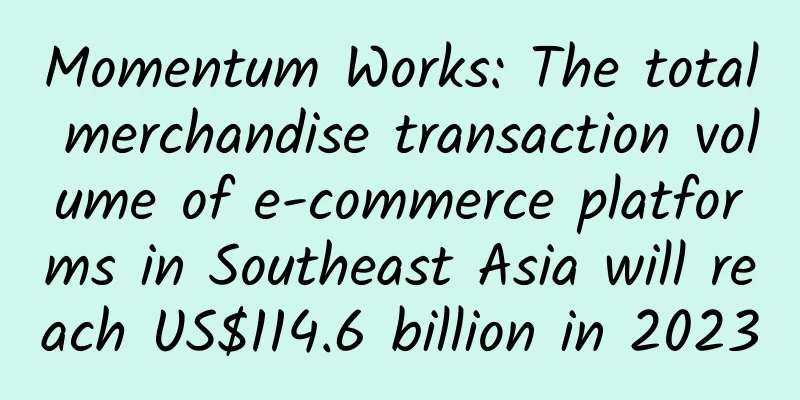Momentum Works: The total merchandise transaction volume of e-commerce platforms in Southeast Asia will reach US$114.6 billion in 2023

|
Today, TikTok Shop is only one step away from topping the Southeast Asian e-commerce market. The latest Southeast Asian e-commerce report released by Momentum Works shows that last year, the total transaction volume of e-commerce platforms in Southeast Asia reached US$114.6 billion, with Shopee ranking first with a market share of 48%, followed by Lazada with 16.4%, and TikTok and Tokopedia each accounting for 14.2%, ranking third. But if we consider that last year TikTok acquired a majority stake in Tokopedia, Indonesia's largest e-commerce platform, and the combined market share of the two reached 28.4%, then TikTok Shop surpassed Lazada to become the second largest player in Southeast Asia. It is worth mentioning that TikTok Shop’s GMV has almost quadrupled compared to 2022, making it the fastest growing e-commerce platform in the region. The current Southeast Asian e-commerce market is still a hot spot worth exploring, with major giants scrambling to make layouts and the competition becoming increasingly fierce. To a certain extent, the rapid rise of TikTok Shop has also reshaped the Southeast Asian e-commerce landscape. The Southeast Asian e-commerce market is about to change again. TikTok Shop is eyeing the market In the past two years, TikTok Shop has already entered the heart of the Southeast Asian e-commerce market. Li Jianggan, founder and CEO of Momentum Works, believes that TikTok has become a "very important player" in Southeast Asia. Especially after its integration with Tokopedia, it is possible for TikTok to surpass Shopee and become the number one e-commerce platform in Indonesia. If it continues to develop at its current rate, it is only a matter of time before TikTok Shop becomes the largest player in the entire Southeast Asian e-commerce market. One of the important reasons why TikTok Shop was able to overtake quickly is that it did not focus on the familiar track of Shopee and Lazada. Shopee and Lazada were both born in the traditional e-commerce era. Over the years, they have already established mature shelf e-commerce systems that newcomers cannot surpass in a short time. TikTok follows the path of Douyin in China and engages in hobby e-commerce, focusing on the misaligned competition of "goods finding people", which has given a little shock to Southeast Asia, which has not yet experienced much baptism of the e-commerce economy. TikTok Shop is a derivative product of the TikTok short video platform. Before the launch of its e-commerce business, TikTok already had a huge number of users in the Southeast Asian market. According to TikTok's official data, as of mid-2023, TikTok's total number of monthly active users in Southeast Asia reached 325 million. In other words, TikTok Shop stands on the shoulders of giants and has the first-mover traffic advantage. The population structure of Southeast Asia as a whole is becoming younger, with more than 50% of the nearly 700 million people under the age of 30. It is reported that by 2030, millennials and Generation Z are expected to account for 75% of ASEAN consumers. Young people love to watch short videos and are very receptive to new things, which is exactly what TikTok Shop wants. More and more people are starting to shop unconsciously while watching short videos and live broadcasts. Merchants doing cross-border trade in Southeast Asia told the media that as long as the live broadcast is done well or the video is well shot, it doesn’t matter if the price is slightly higher than other platforms. Therefore, live streaming e-commerce has gradually become the shopping method pursued by Southeast Asian consumers in the past two years. According to a research report by Milieu Insight, in Southeast Asia, 82% of respondents have entered a live broadcast room, 48% of users visit a live broadcast room at least once a week, and 63% have bought something in a live broadcast room. Since last year, the emergence of generative AI has further reduced the production costs of short videos and live broadcasts. The domestic Douyin platform still holds a relatively cautious attitude towards digital people live streaming and selling goods. It has set up many rules and regulations and has severely punished accounts that improperly use AI technology to generate virtual characters to publish content. However, TikTok Shop not only allows digital people to replace real anchors to live stream and sell goods, but also allows merchants to record video sounds in advance and then play them in rotation. In order to make its e-commerce ecosystem more complete, last year, TikTok Shop also completed the shelf e-commerce of "people looking for goods", entering an era of growth on two legs. It can be said that TikTok Shop is making full efforts to capture the Southeast Asian e-commerce market. Shopee and Lazada warning bells Before the invasion of TikTok Shop, Shopee and Lazada had long occupied the top two positions in the Southeast Asian e-commerce market. Shopee was founded in 2015. Backed by Tencent, it quickly attacked the Southeast Asian market. In just four years, it became the largest e-commerce platform in Southeast Asia. At its peak , the parent company's market value exceeded US$200 billion, and it was once unparalleled. Lazada, which was established earlier, lost in the years of competition with Shopee, but as a very important part of Alibaba's overseas layout, Alibaba has always placed high hopes on it. Since 2016, Alibaba has invested more than 10 billion yuan in it every year. Over the years, Lazada has also firmly maintained its second place. The aggressive emergence of TikTok Shop caught the two old players off guard and forced them to respond quickly. Shopee and Lazada want to defeat magic with magic. We can see that they have been more active in live streaming e-commerce in the past two years. Shopee in particular, in August last year, its parent company Sea said it would increase investment to build a live broadcast ecosystem and improve the platform's logistics capabilities. It is reported that Shopee also provides brands with a list of influencers, helps companies contact local influencers, provides discounts, and launches live broadcast marathons and other activities during the 10.10 promotion. When announcing its Singles’ Day sales figures last year, Shopee specifically highlighted the outstanding performance of its livestreaming business, with Shopee Live’s cumulative views reaching 6.7 billion, which helped many brands achieve significant sales growth. In the first quarter of this year, Shopee set another e-commerce goal in Thailand, aiming to surpass e-commerce by providing upgraded services, directly targeting TikTok Shop. Last year, Lazada also upgraded its cross-border logistics system, achieved a 3-day delivery time for cross-border packages, launched a fully managed service exclusive shopping channel Choice, and so on, thereby improving its competitive advantage. Shopee and Lazada have worked hard in many aspects, including live streaming, logistics timeliness, and seller subsidies, in order to defend their status as the big brother and the second brother to the death. Southeast Asia, a hotbed for e-commerce Over the years, Internet giants have, directly or indirectly, liked to make money in Southeast Asia. Southeast Asian e-commerce is still in its infancy, with e-commerce sales accounting for only 10% of total retail sales, lower than the global average of 19%, and has huge development potential. Its consumption concept and stage are more like China more than a decade ago, when traditional e-commerce had not yet reached its end and was impacted by live streaming e-commerce. According to Bain statistics, the GMV of e-commerce in Southeast Asia was US$131 billion in 2022, and is expected to reach US$211 billion by 2025, with a compound annual growth rate of 17% in a few years. Whether it is TikTok Shop, Shopee, or Lazada, to a certain extent, they are all repeating the path that led to the rise of Chinese e-commerce. But so far, the battle situation is still unclear and there are still many variables. As an emerging foreign player, TikTok Shop has money and users, which has indeed dealt a heavy blow to the two old players. However, due to its lack of understanding of localization, it has also been caught in a compliance crisis. Starting from the second half of last year, TikTok was first stopped from operating its e-commerce business by the Indonesian government, and then the Malaysian government also considered following Indonesia's footsteps and formulating corresponding rules. If TikTok had not later established an e-commerce strategic partnership with GoTo Group and bought 75.01% of GoTo's e-commerce platform Tokopedia for US$840 million, thus obtaining a "local account" in Southeast Asia, it would have almost withdrawn from the market. Better adapting to the political and cultural environment of Southeast Asia has become an urgent problem that TikTok Shop needs to solve. In contrast, platforms such as Shopee and Lazada have a deeper understanding of localization, act more cautiously, and have a more appropriate grasp of local business policies. Although the opponents are very strong, the first-mover advantage accumulated over the years and the huge scale formed will be difficult to be surpassed in a short time. A fierce competition for e-commerce market share is continuing in Southeast Asia. From the webmaster's home |
<<: FedEx: Entering the Indian cross-border e-commerce market
>>: FedEx: Entering China's cross-border e-commerce market
Recommend
Tencent Advertising & Tongcheng Travel: 2022 Summer Travel Report
Tencent Advertising and Tongcheng Travel jointly ...
The efficacy and function of giant scorpion grass [picture]
Giant scorpion grass [picture] is a very common C...
The efficacy and function of Yibaohua
After thousands of years of sedimentation and acc...
Where did the ancient forests that did not turn into coal eventually go?
In the heavy rain, a group of Placerias slowly wa...
Can Poria cocos be eaten raw?
We all know that Poria cocos is a very common Chi...
What are the beauty effects of Atractylodes macrocephala
Atractylodes is a relatively common Chinese herba...
Zhang Fusuo and the "Science and Technology Courtyard": Stepping out of the laboratory and taking root in the fields
Your browser does not support the video tag Food ...
Staying up late = unhealthy? Not getting enough sleep for 8 hours is bad for your health? It's not that simple
Workers usually stay up late to work overtime, an...
Why doesn’t milk taste as good as it used to?
In addition to the humanistic factor that "m...
Crossing the no-man's land again! Three highways across the "Sea of Death". How did the "infrastructure maniac" build them?
On June 30, the Xinjiang Yuli to Qiemo highway - ...
Is it really feasible to “promote DNA database to effectively combat human trafficking”?
Recently, a member of the National Committee of t...
The efficacy and function of mountain aconite leaves
Aralia dasyphylla leaves are a very common medici...
The efficacy of drinking raspberry water
Raspberry is a kind of traditional Chinese medici...
The efficacy and function of bitter sunflower and scorzonera
Scorzonera is a traditional Chinese medicine. In ...
EcommerceBytes: Return Rates on Amazon, eBay, and Etsy
EcommerceBytes conducted a seller survey on the r...









